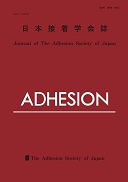All issues

Volume 44, Issue 10
Displaying 1-3 of 3 articles from this issue
- |<
- <
- 1
- >
- >|
Review
-
Makoto ENDO2008 Volume 44 Issue 10 Pages 387-391
Published: October 01, 2008
Released on J-STAGE: October 31, 2015
JOURNAL FREE ACCESSDownload PDF (1680K)
Original Paper
-
Zenichi MIYAGI, Soichi SAIGA2002 Volume 44 Issue 10 Pages 380-386
Published: October 01, 2002
Released on J-STAGE: June 30, 2014
JOURNAL FREE ACCESSThe micro peeling of Pressure Sensitive Adhesives (PSA) product from the curved surface is observed as a flagging phenomenon in practical use. The standardized test methods in American Society for Testing and materials (ASTM), Pressure Sensitive Tape Council (PSTC) and Japanese Industrial Standards (JIS) have been used in quality control and research to evaluate the flagging properties of PSA. However, the current test method lacks the measurement resolution and accuracy for analyzing the micro peel length. To improve the performance of peeling adhesion test from the curved surface as an adherend and to advance the specifications of the test method, a new micro peeling test apparatus using the electronic force balance was developed. The measurement resolution of peel length is 0.78 μm at the adherend weight of 10g, which is approximately equivalent to the peel load by a cylindrical adherend. In the experiments by this apparatus, the peel length and peel rate of an acrylic PSA were measured under various combinations of the factors chosen from the test conditions. Most peel length of the PSA increased exponentially after the load was applied, and its rate decreased with time until it becomes constant. As a result of analysis of variance, the significance of interaction related to the backing thickness of specimen was recognized on the peel length. The micro peeling phenomena for the curved surface are based on the peel stringiness properties resulting from cohesive and interfacial failure of the PSA, and the effects of these results have a dependence on the influence of backing thickness and crosslinking agent ratio of specimen.View full abstractDownload PDF (2567K)
Original Paper
-
Koun TAKAHASHI, Hideo MORITA, Misao KONDOU, Fumiki TOMIOKA, Shintaro K ...2008 Volume 44 Issue 10 Pages 373-379
Published: October 01, 2008
Released on J-STAGE: June 30, 2014
JOURNAL FREE ACCESSWe developed long handling arms which were applied to transfer press machine for car body manufacturing. The arms consisted of hollow aluminum alloy pipes reinforced with CFRP plates bonded adhesively on their surfaces to improve their stiffness and to reduce their vibration. We investigated analytically and experimentally the joint geometries suitable for the fatigue life to enhance the durability of the adhesively bonded joint between aluminum alloy and CFRP. Three types of joint geometry were examined by Finite Element Method. The first type was the joint geometry without a fillet at the adhesive end. This type was defined as the standard joint geometry. The second type was the joint geometry with fillets in the adhesive ends. The third type was the joint geometry with aluminum alloy patches in the adhesive ends. The second type and the third type were considered to decrease their stress concentration at the ends of the adhesive layer comparing to the standard joint geometry. As the result of the calculation, we found that the stress in adhesive layer near the adhesive end was low in order of the third type, second type and the first type. Fatigue tests of the standard joint geometry and the third type were carried out. As the result of fatigue tests, we found that the fatigue life of the third type was longer than the standard joint geometry.View full abstractDownload PDF (2616K)
- |<
- <
- 1
- >
- >|